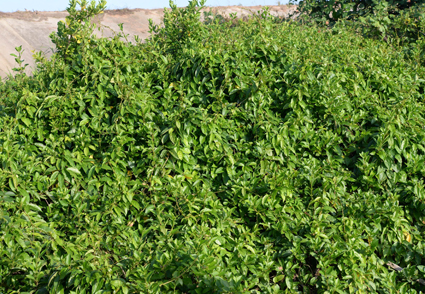Abstract
A newly recorded subspecies, Sarcolobus globosus subsp. peregrinus (Blanco) Rintz, was reported. This subspecies was previously known to be distributed in Southeast Asia islands, which was recently found in Zhanjiang, Guangdong, China. Detailed morphological description, field photos and geographical distribution are provided in this study. Additionally, the whole chloroplast genome was sequenced by the Illumina sequencing technology. The annotated results revealed that the chloroplast genome has a conserved quadripartite structure, with a pair of inverted repeat regions (IRs) separating the large single copy (LSC) region from the small single-copy (SSC) region, resulting in a total length of 161,561 base pairs (bp). The phylogenetic analysis shows that S. globosus subsp. peregrinus is clustered with its type subspecies (i.e., subsp. globosus), and the significant difference in branch length between them indicates a large variation in their evolutionary rates. These results provide new insights into the Apocynaceae of China.
References
- Dierckxsens, N., Mardulyn, P. & Smits, G. (2017) NOVOPlasty: de novo assembly of organelle genomes from whole genome data. Nucleic acids research 45 (4): e18. https://doi.org/10.1093/nar/gkw955
- Forster, P.I. (1991) A taxonomic revision of Sarcolobus R. Br. (Asclepiadaceae: Marsdenieae) in Australia and Papuasia. Austrobaileya 3: 335–360. https://doi.org/10.5962/p.365759
- Forster, P.I. (1992) A taxonomic revision of Sarcolobus (Asclepidaceae: Marsdenieae) in Fiji. Australian Systematic Botany 5 (5): 593–596. https://doi.org/10.1071/SB9920593
- Forster, P.I. (1993) Taxonomic Relationships and Status of the Genus Dorystephania (Asclepiadaceae: Marsdenieae) from the Philippines and Borneo. Australian Systematic Botany 4: 351–357. https://doi.org/10.1071/SB9930351
- Kalyaanamoorthy, S., Minh, B.Q., Wong, T.K.F., von Haeseler, A. & Jermiin, L.S. (2017) ModelFinder: fast model selection for accurate phylogenetic estimates. Nature Methods 14 (6): 587–589. https://doi.org/10.1038/nmeth.4285
- Liede‐Schumann, S., Reuss, S.J., Meve, U., Gâteblé, G., Livshultz, T., Forster, P.I., Wanntorp, L. & Rodda, M. (2022) Phylogeny of Marsdenieae (Apocynaceae, Asclepiadoideae) based on chloroplast and nuclear loci, with a conspectus of the genera. Taxon 71 (4): 833–875. https://doi.org/10.1002/tax.12713
- Lin, G.X., Wu, X.D., Xu, F.H., et al. (2022) Coastal Plants in Leizhou Peninsula. China Forestry Publishing House, Beijing. pp. 15.
- McHone, E., Won, H. & Livshultz, T. (2015) Sarcolobus cambogensis (Marsdenieae, Asclepiadoideae, Apocynaceae): A new rheophytic shrub from Cambodia. Phytotaxa 197 (1): 45–53. https://doi.org/10.11646/phytotaxa.197.1.5
- Omlor, R. (1998) Generische Revision der Marsdenieae (Asclepiadaceae). Shaker Verlag, Aachen. 257 pp.
- Qu, X.J., Moore, M.J., Li, D.Z. & Yi, T.S. (2019) PGA: a software package for rapid, accurate, and flexible batch annotation of plastomes. Plant Methods 15 (1): 1–12. https://doi.org/10.1186/s13007-019-0435-7
- Rintz, R.E. (1980) A revision of the genus Sarcolobus (Asckepiadaceae). Blumea 26: 65–79.
- Ronquist, F. & Huelsenbeck, J.P. (2003) MrBayes 3: Bayesian phylogenetic inference under mixed models. Bioinformatics 19 (12): 1572–1574. https://doi.org/10.1093/bioinformatics/btg180
- Tillich, M., Lehwark, P., Pellizzer, T., Ulbricht-Jones, E.S., Fischer, A., Bock, R. & Greiner, S. (2017) GeSeq-versatile and accurate annotation of organelle genomes. Nucleic Acids Research 45 (W1): W6–W11. https://doi.org/10.1093/nar/gkx391


